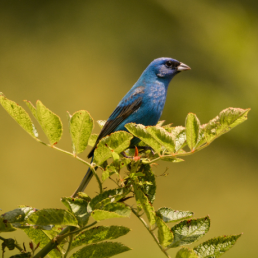

Join BirdNote tomorrow, November 30th!
Illustrator David Sibley and actor H. Jon Benjamin will face off in the bird illustration battle of the century during BirdNote's Year-end Celebration and Auction!
A typical bird nest will have maybe four to six eggs neatly arranged by the parent to hunker down on. But in one Rhea nest, you may find between 50 and 80 eggs! And they’re not all from the same set of parents. Male Rheas mate with several females and then build a single nest on the ground to hold all the eggs from each of them.
Listen to this episode in Spanish here.
BirdNote®
Rhea Nesting Is Mind-boggling
Written by Bob Sundstrom
This is BirdNote.
[Rhea chick calling: https://www.xeno-canto.org/49632, 0.02-.08]
A typical bird nest will have maybe four to six eggs neatly arranged for a parent to hunker down on.
Now, meet the Greater Rhea, South America’s largest bird. Rheas are four- to five-foot-tall flightless birds that look a good deal like Ostriches. You can find between 50 and 80 eggs in one Rhea nest! But they’re not all from the same set of parents.
Male Rheas mate with several females and then build a single nest on the ground to hold all the eggs from each of them.
Female Rheas wander around during the breeding season and mate with different males, laying eggs in each of their partner’s nests.
Males usually stay put after breeding and attend the nest. But a male Rhea might recruit a lower-ranking male to look after his first nest while he goes off to start another nest, now mating with a second set of females.
[https://www.xeno-canto.org/49632, 0.02-.08]
As the Rhea eggs are about to hatch, the chicks — while still inside the egg — begin to make a curious whistle. Imagine fifty or more all whistling at once:
Multiplied: [https://www.xeno-canto.org/49632, 0.02-.08]
Sometimes young chicks like to nestle in the feathers of the male’s back — good thing he has such a nice broad back for all those chicks!
For BirdNote, I’m Ashley Ahearn.
###
Producer: John Kessler
Executive Producer: Sallie Bodie
Editor: Ashley Ahearn
Associate Producer: Ellen Blackstone
Assistant Producer: Mark Bramhill
Bird sounds provided by Xeno-Canto.org. Recorded by Rosendo Fraga.
BirdNote’s theme was composed and played by Nancy Rumbel and John Kessler.
© 2020 BirdNote January 2020/2022
ID# RHEA-01-2020-01-30 RHEA-01 Narrator: Ashley Ahearn
[sources: https://www.nationalgeographic.com/animals/birds/g/greater-rhea/
https://www.newworldencyclopedia.org/entry/Rhea_(bird)]
https://www.youtube.com/watch?v=DGEugVXh1go



